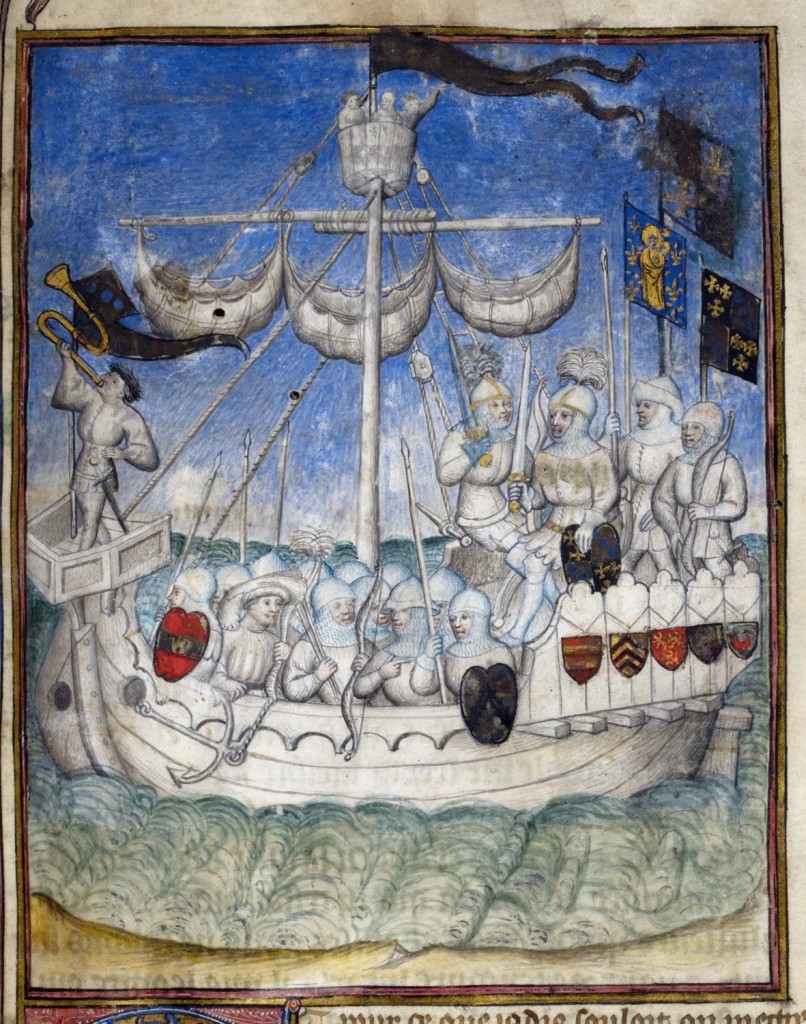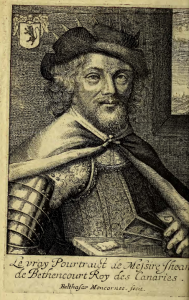,%20Le%20Canarien,%20tomo%20I_portada_14230f442d9ad53d95eb03b5aa705aab.jpg)
Front cover of the first volume of Le Canarien 1959 edition by Professors Elías Serra Ràfols and Alejandro Cioranescu (source: Biblioteca Virtual Viera y Clavijo).
Le Canarien (The Canarian) is the oldest of the known Canarian chronicles. Originally written over six-hundred years ago, it is the first specific account almost entirely devoted to the European conquest of the Archipelago. Its initial authors, two French priests: Jehan Le Verrier and Pierre Boutier, chaplains to the conquest expedition assembled in 1402 by Norman Baron Jehan IV de Béthencourt and his partner, Pictavin Knight Gadifer de La Salle, as both of them admit:
[…] Gadifer de La Sale and Jehan de Béthencourt, knights born in the Kingdom of France, have undertaken this voyage to honor God and for maintenance and increasement of our holy faith, to parts of the South, to certain islands that are on the side thereof, which they call islands of Canaria inhabited by infidels people with different laws and different languages, […] with the intention of turning them and attract them to our faith; That is why this book is called the Canarian. And we, Brother Pierre Boutier, monk of Saint-Juoin-des-Marnes and Mr. Jehan Le Verrier, priests and chaplains and servants of the knights named above, have begun to write down all the things that happened to them from the beginning and the whole form of their government, of which we could have had true knowledge, since they left the Kingdom of France until […] Béthencourt arrived here at the islands; and thereafter came the writing in other hands, that will resume it with all the truth until the end of their conquest.
Le Canarien (text G) –SERRA (1964), pp. 14-16– (this translation by PROYECTO TARHA).
Truth is that those other hands were not as accurate as the original authors expected. In fact, having either the original or originals dissappeared, the two oldest known copies of this account are perfect examples of hagiographic manipulation.
We might find the root of such manipulation on the personal confrontation between the two leaders of the conquest, which begins after the return of Jehan de Béthencourt from his voyage to Seville, undertaken on the pretext of seeking reinforcements and supplies for the campaign, while Gadifer de La Salle remained in the Archipelago assuming simultaneously and alone, the burden of the colony rule, the war on the Canaries and the repression of the riots staged by some of the other adventure members.
Indeed, De la Salle learned how Béthencourt had not only delayed the shipment of the promised refreshments but had also rendered in vassalage the conquered islands –Lanzarote, Fuerteventura and El Hierro– and those yet to be conquered to King Henry III of Castile, receiving as an exclusive right the title of Lord of the Islands of Canaria, created for this purpose for the Norman. And all behind his back.
Following this incident an undeclared war between the two leaders would begin gradually losing its sneaky character and reaching its peak in De la Salle’s resigning to his participation in the campaign after seeing thwarted his attempt to get a fair deal of the royal patronage, with such exotic events as the following and almost puerile exchange of threats:
[…] and in the letter Lord Gadifer wrote to Monsieur de Béthencourt, everything that was written was only: –If you come here, if you come here, if you come here, and nothing more. Then Monsieur de Béthencourt answered him, […]: –If I find you there, if I find you there, if I find you there.
Le Canarien (text B) –SERRA (1960), pp. 220-222– (this translation by PROYECTO TARHA).

Original miniature from the Egerton 2709 manuscript which shows Jehan IV de Béthencourt and Gadifer de La Salle sitting on the stern of the ship that would take them to the Canary Islands (source: The British Library).
Text G: Gadifer de La Salle’s version
Codex Egerton 2709, preserved in The British Library, and known as Text G following the notation by Professors Elías Serra Ràfols and Alejandro Cioranescu who ascribed its authorship to Gadifer de La Salle, [1]SERRA (1959), pp. 230, 243 -244. it is the shortest and sober of the two existing manuscripts, lacking any outstanding illustration except one sole miniature on the cover depicting the ship chartered by De la Salle to carry the first troops of the Conquest, and showing curious and significant details that reveal the bitterness of that confrontation, as the figures of the two leaders sitting on the stern, being the Pictavin certainly identified thanks to the coat of arms on the shield he holds with his left hand while Béthencourt’s is hidden behind the first character. De la Salle’s blazon also appears on the pennants fluttering in the wind, while that of Béthencourt is only to be suspected behind two manifestly intentional smudges on the stern flag.[2]See footnote in SERRA (1959), p. 232.
Text G’s main features follow:
- Probably redacted between 1420 and 1430.
- It does neither have a title nor author or copyist.
- Lacks illustrations except the aforementioned miniature and a number of ornamental motives.
- It is unfinished and also lacks one folio, that was stripped off.
- Contains a catechism targetting the indigenes’ evangelization.
- Criticises the Schism of the Catholic Church.
- Reviews a book written by a friar who had explored the north of Africa.
- The account of the Conquest abruptly ends at the building of the Tower of Valtarajal.
- It ends with a description of each island and of the looks and customs of their inhabitants.

Illustration titled “How Béthencourt and Gadifer had disputes” included in the 61st chapter of Text B, showing Jehan IV of Bethencourt and Gadifer de La Salle on the island of Fuerteventura before Riche Roque and Baltarhais castles (source: Wikimedia Commons) .
Text B: Jehan V de Béthencourt’s version
Codex Mont-Ruffet, kept in the French city of Rouen, at the Bibliothèque patrimoniale Jacques Villon, catalogue number Ms mm 129 (CGM 1399),[3]Data provided to us by Heritage Assistant Lucie Garcia by personal communication on April 21th 2016. was the first discovered and published version of Le Canarien, being known as Text B, its authorship ascribed to Jehan V de Béthencourt, nephew of the Norman conqueror. This version is believed to be a partial copy of the Text G, extended and modified in order to glorify the figure of the Baron in detriment of its partner, Gadifer de La Salle. [4]SERRA (1959), pp 255-256. Its main features are:
- Probably written between 1488 and 1491.
- Its author ignores almost everything about the Canaries and Jehan IV de Béthencourt.
- Redacted in a slightly more modern French than that of Text G.
- Contains many low-quality, non-realistic illustrations.
- Béthencourt’s name replaces that of Gadifer de La Salle in many passages.
- The quality of its calligraphy decreases as the text progresses.
- Includes Text G Catechism as well as the aforementioned friar’s book review and also the description of the Islands and their inhabitants.
- It resumes the account abandoned by Text G until Béthencourt’s death after his last returning to Normandy.
Modern editions

Although the illustration prepared by Engraver Balthasar Moncornet for the Pierre Bergeron’s edition of Le Canarien’s Text B (1630) claims to be the true portrait of Messire Jhean de Béthencourt, King of the Canaries, it is very likely to be an idealized image of the Norman Baron (source: Archive.org).
Apart from the various classic editions published of this chronicle, of which we can find a complete listing and outlines in an article by Professor José Barrios García titled On the lines of textual transmission of Le Canarien: manuscripts, copies and editions, we recommend that classical critical edition titled Le Canarien: French chronicles on the Conquest of the Canaries, by Professors Elías Serra Ràfols (Mahón, Menorca, 1898 – La Laguna, Tenerife, 1973) and Alejandro Cioranescu (Moroeni, Romania, 1911 – Santa Cruz de Tenerife, 1999), published in three volumes by the Instituto de Estudios Canarios, the Spanish Council for Scientific Research and El Museo Canario between 1959 and 1964.
Nevertheless, more recent editions do exist, as Le Canarien. A Portrait of Two Worlds, in two volumes –Texts and Contexts– by Professor Eduardo Aznar Vallejo, accompanied by a number of interesting studies signed by experts in different disciplines -Archaeology, Biology, Philology, History of Art, among others–.
In any case, it is always a pleasure to enjoy the controversial confrontation between the two versions of this classic, featuring a reading as agile as enjoyable and intense.
And, incidentally, may this be food for thought on how in other coordinates, with stories of much less entity, major films have been produced.
Antonio M. López Alonso
References
- Barrios García, J. (1993). Sobre las líneas de transmisión textual del Le Canarien: manuscritos, copias y ediciones. V Jornadas de Estudios sobre Fuerteventura y Lanzarote, 1:415–429.
- Serra Ráfols, E. y Cioranescu, A. (1959). Le Canarien. Crónicas francesas de la conquista de Canarias. I. Introducción. Instituto de Estudios Canarios – Consejo Superior de Investigaciones Científicas – El Museo Canario.
- Serra Ráfols, E. y Cioranescu, A. (1960). Le Canarien. Crónicas francesas de la conquista de Canarias. II. Texto de Juan V de Bethencourt. Instituto de Estudios Canarios – Consejo Superior de Investigaciones Científicas – El Museo Canario.
- Serra Ráfols, E. y Cioranescu, A. (1965). Le Canarien. Crónicas francesas de la conquista de Canarias. III. Texto de Gadifer de La Salle. Apéndices e índices. Instituto de Estudios Canarios – Consejo Superior de Investigaciones Científicas – El Museo Canario.
